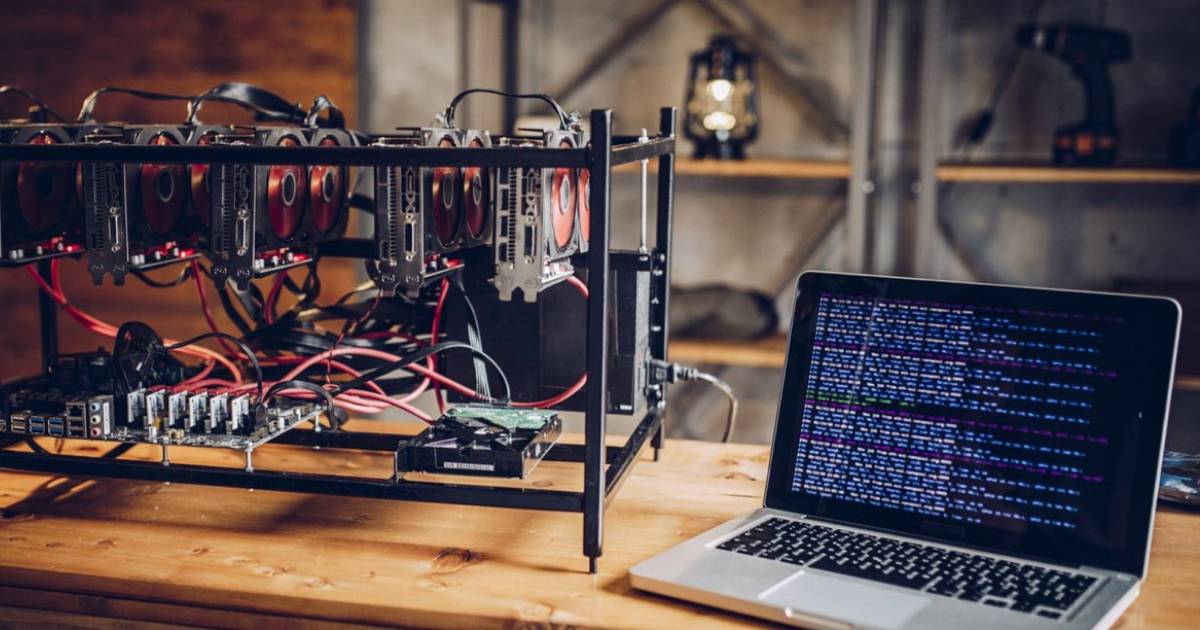Cryptocurrency mining has become a cornerstone of the blockchain ecosystem, enabling the validation of transactions and the creation of new digital assets. At the heart of this process lies the crypto mining rig, a specialized computer designed to solve complex cryptographic equations.
Whether you’re a tech enthusiast or a budding miner, this guide will walk you through everything you need to know about what a crypto mining rig is, why it’s used, and how to build one step-by-step.
What is a Crypto Mining Rig?
A crypto mining rig is a customized computer built specifically for mining cryptocurrencies. Unlike a standard PC, which relies on a central processing unit (CPU) for general tasks, a mining rig is equipped with multiple graphical processing units (GPUs). These GPUs are optimized for solving the cryptographic puzzles required to validate transactions on a blockchain.
How Does a Mining Rig Work?
- Cryptographic Equations: Mining rigs solve complex mathematical problems to verify transactions and add them to the blockchain.
- Block Rewards: Successful miners are rewarded with newly minted cryptocurrency, such as Bitcoin or Ethereum.
- Hash Rate: The speed at which a rig can solve these equations is measured in hash rate (e.g., terahashes per second, or TH/s).
“A mining rig is like a digital gold miner, extracting value from the blockchain through computational power.” – Blockchain Expert
Why Use a Mining Rig?
Role in Blockchain Technology
Mining rigs play a critical role in maintaining the integrity and security of blockchain networks. By validating transactions, they ensure decentralization and prevent double-spending.
Profitability of Mining
- Earnings Potential: Miners can earn significant rewards, especially during bull markets. For example, in 2021, Bitcoin miners earned over $15 billion in revenue.
- Factors Affecting Profitability:
- Hash Rate: Higher hash rates increase the chances of solving blocks.
- Electricity Costs: Mining consumes substantial power; efficiency is key.
- Crypto Market Trends: Prices of mined coins directly impact profitability.
Transition to Proof-of-Stake
While mining remains essential for proof-of-work cryptocurrencies like Bitcoin, some networks are shifting to proof-of-stake (PoS). For instance, Ethereum’s transition to PoS in 2022 reduced the demand for mining rigs in its ecosystem. However, Bitcoin and other PoW coins still rely heavily on mining.
What Components are Required to Build a Mining Rig?
Building a mining rig requires careful selection of hardware and software components. Here’s a breakdown of what you’ll need:
Hardware Components
- GPUs (Graphical Processing Units):
- The backbone of any mining rig.
- Popular models include NVIDIA GeForce RTX 3060 Ti and AMD Radeon RX 580.
- Motherboard:
- Must support multiple GPUs (e.g., ASUS B250 Mining Expert).
- CPU (Central Processing Unit):
- A basic processor like Intel Celeron or AMD Ryzen 3 is sufficient.
- RAM:
- Minimum 4-8GB for smooth operation.
- Power Supply Unit (PSU):
- Must provide enough wattage for all components (e.g., 1200W for a 6-GPU rig).
- Storage:
- SSD or HDD (120GB minimum) for the operating system and mining software.
- Risers:
- Elevate GPUs for better airflow and cooling.
- Mining Frame:
- Open-air frames for optimal ventilation.
Software Components
- Mining Software:
- Examples: CGMiner, NiceHash, HiveOS.
- Operating System:
- Windows, Linux, or specialized mining OS like SimpleMining.
- Crypto Wallet:
- To store mined cryptocurrency securely (e.g., MetaMask, Ledger).
Additional Requirements
- Stable Internet Connection: Essential for uninterrupted mining.
- Cooling Solutions: Fans or liquid cooling to prevent overheating.
- Surge Protector or UPS: Protects against power surges.
How to Build a Mining Rig: A Step-by-Step Guide
Building a mining rig can be a rewarding but challenging process. Follow these steps to assemble your rig:
Step 1: Assemble the Frame
- Choose an open-air frame for better airflow.
- Secure the motherboard to the frame using screws.
Step 2: Install Core Components
- Mount the CPU, RAM, and storage on the motherboard.
- Connect the power supply unit to the motherboard.
Step 3: Add GPUs
- Install GPUs on the motherboard using risers.
- Ensure proper spacing between GPUs for ventilation.
Step 4: Connect Power and Cables
- Connect the PSU to the motherboard and GPUs.
- Double-check all connections to avoid power issues.
Step 5: Install Software
- Install the operating system and mining software.
- Configure the mining software with your crypto wallet address.
Step 6: Test and Optimize
- Power on the rig and test its stability.
- Monitor temperatures and adjust fan speeds or overclocking settings.
Pro Tip: Start with one GPU to ensure everything works before adding more.
Bitcoin Mining Rig vs. Crypto Mining Rig: Key Differences
Bitcoin Mining Rigs
- Hardware: Use ASICs (Application-Specific Integrated Circuits).
- Efficiency: Highly efficient for Bitcoin mining but expensive.
- Cost: Upfront costs can exceed $10,000.
Crypto Mining Rigs
- Hardware: Use GPUs, making them versatile for multiple cryptocurrencies.
- Cost: Lower initial investment but higher electricity consumption.
- Flexibility: Can switch between coins based on profitability.
Crypto Mining Setup: Tips for Success
Cost-Benefit Analysis
- Calculate ROI based on hardware costs, electricity rates, and crypto prices.
Energy Efficiency
- Use energy-efficient GPUs and PSUs to reduce operational costs.
Cooling Solutions
- Invest in proper cooling to extend hardware lifespan.
Mining Pools
- Join a mining pool for consistent earnings. Popular pools include F2Pool and Slush Pool.
Security Measures
- Use secure wallets and enable two-factor authentication for mining software.
Future of Crypto Mining Rigs
Impact of Proof-of-Stake
- The shift to PoS reduces the demand for mining rigs in some ecosystems.
Emerging Trends
- Green Mining: Use of renewable energy sources.
- AI Optimization: AI-driven tools for maximizing mining efficiency.
Long-Term Viability
- Mining remains relevant for Bitcoin and other PoW coins, but miners must adapt to changing technologies.
Final Thoughts
Building a crypto mining rig is a complex but rewarding endeavor. By understanding the components, processes, and challenges involved, you can make informed decisions and maximize your mining potential.
As the cryptocurrency landscape evolves, staying updated on trends and innovations will be key to long-term success.
FAQ’s
How long does it take to mine $1 of Bitcoin?
Mining $1 of Bitcoin depends on your rig’s hash rate, electricity costs, and Bitcoin’s price. For example, with a mid-range rig (e.g., 100 TH/s), it could take several hours to a day to mine $1 worth of Bitcoin. Use tools like WhatToMine to calculate exact earnings.
Is it profitable to build a crypto mining rig?
Profitability depends on factors like hardware costs, electricity rates, and cryptocurrency prices. While mining can be profitable during bull markets, high energy costs and competition often reduce margins. Always conduct a cost-benefit analysis before investing.
Are crypto mining rigs legal?
Yes, crypto mining rigs are legal in most countries. However, some regions restrict or ban mining due to energy consumption concerns or regulatory issues. Always check local laws before setting up a mining operation.
Is crypto mining still profitable?
Crypto mining can still be profitable, but it’s highly competitive. Factors like electricity costs, hardware efficiency, and crypto prices determine profitability. Mining pools and energy-efficient setups can improve earnings.
Can I mine Bitcoin for free?
Mining Bitcoin isn’t free due to hardware and electricity costs. However, you can join cloud mining services or earn small amounts through Bitcoin faucets, though these methods are less profitable than traditional mining.
How many bitcoins are left?
As of October 2023, over 19.4 million Bitcoins have been mined, leaving approximately 1.6 million to be mined. The last Bitcoin is expected to be mined in 2140 due to the halving mechanism.
Is mining Bitcoin illegal?
Mining Bitcoin is legal in most countries, but some nations like China and Algeria have banned it due to energy concerns or regulatory issues. Always verify local regulations before starting.
How much does it cost to mine 1 Bitcoin?
The cost to mine 1 Bitcoin varies by location and hardware. On average, it costs $15,000-$20,000 in electricity and hardware expenses. Regions with cheap electricity (e.g., Iceland) have lower costs.
Can a normal person mine Bitcoin?
Yes, anyone can mine Bitcoin with the right hardware and setup. However, due to high competition and costs, most individual miners join mining pools to increase their chances of earning rewards.
Is Bitcoin mining worth it?
Bitcoin mining can be worth it if you have access to cheap electricity and efficient hardware. However, for most individuals, the high upfront costs and competition make it less profitable than simply buying Bitcoin.
How much can 1 Bitcoin miner make in a day?
A single Bitcoin miner’s daily earnings depend on its hash rate and electricity costs. For example, a rig with 100 TH/s might earn $5-$10 per day before deducting electricity expenses. Use mining calculators for precise estimates.
Who owns the most Bitcoin?
The largest known Bitcoin holder is Satoshi Nakamoto, the anonymous creator of Bitcoin, who reportedly owns 1 million BTC. Other major holders include crypto exchanges like Binance and institutional investors like MicroStrategy.









